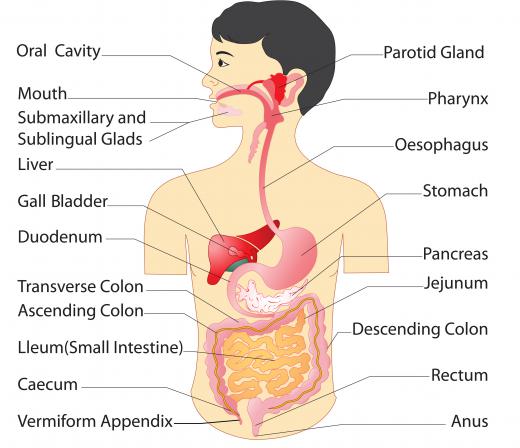What Is Diethanolamine?
Diethanolamine, or DEA, is an organic compound synthesized from a reaction of ethylene oxide and ammonia, and it has been produced in large industrial quantities since the early 1930s. At room temperature, it is either a clear, hygroscopic liquid that attracts moisture from the air, or a white crystalline solid that can have a slight smell of ammonia as the temperature rises. The compound can be used for many commercial purposes, but chief among them is as an intermediate wetting agent in cosmetics and health and beauty aids such as shampoo, lotions, and creams, as it acts to create a thick lather or creamy consistency when mixed with water or spread onto the surface of skin. Diethanolamine is also used in the manufacture of textiles, pharmaceuticals, and herbicides. One important industrial use for it is as a gas scrubber in the petroleum and natural gas industries to remove dangerous hydrogen sulfide gas byproducts produced in refining.
It has been known for some time that diethanolamine creates health risks upon exposure in the many industries where it is used, including as an ingredient in hand-applied waxes, polishes, and corrosion inhibitors. The greatest risk to human health that it poses, however, is as an ingredient in cosmetic products applied directly and repeatedly to the skin. Research has shown that, over time, DEA will chemically react with other constituents in these products to create an extremely potent carcinogenic chemical called nitrosodiethanolamine (NDEA).

Reports of NDEA's adverse affects on human health link it to cancers of the stomach, esophagus, liver, and bladder. Studies have shown that NDEA is carcinogenic and toxic in 44 different species of experimental animals on which it has been tested. While the US Environmental Protection Agency (EPA) and Food and Drug Administration (FDA) acknowledge the health risks of diethanolamine, little formal government documentation exists as to specific, detailed toxicology due to the fact that cosmetics are only casually regulated by the US federal government. It is widely considered, however, to be one of the riskiest of chemical compounds used in cosmetics products as of 2011 due in part to its propensity to degrade to NDEA.

When diethanolamine is sold by chemical producers, it is available in different concentration levels that can contain trace elements of related amine compounds such as monoethanolamine and triethanolamine. This fact has led to the labeling of DEA in numerous ways, with the chemical having at least 11 other trade names which include cocamide DEA, TEA-lauryl sulfate, cocamide MEA, DEA oleth-3 phosphate, lauramide DEA, DEA-cetyl phosphate, linoleamide MEA, oleamide DEA, stearamide MEA, myristamide DEA, and triethanolamine. Each of these compounds can contain trace elements of diethanolamine, or it can be the major ingredient in such chemicals. This is a result of the fact that it is a polyfunctional chemical that readily binds with related amine or ammonia and diol- or ethylene-based compounds.

When sold as DEA, the chemical is usually 99.3%-pure DEA, and is commercially a 0.45% trace element of monoethanolamine and a 0.25% constituent of triethanolamine. Some industrial producers also offer a reduced concentration of diethanolamine at 85% mixed with 15% deionized water for shipment to colder climates, as it has some ability to inhibit the freezing of products. The largest use for the product in the US is as a surfactant or foaming agent at 39%, and 30% of production of DEA goes to the gas industry as a scrubbing chemical. Remaining uses are divided up amongst textile, metalworking, agricultural, and related commercial interests.
AS FEATURED ON:
AS FEATURED ON:













Discussion Comments
Is this chemical suitable to flush inside scuba cylinders to prevent flash rust coatings? Can it be purchased as a soluble solution at room temperature?
Post your comments